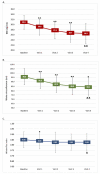Reduction of Cardio-Metabolic Risk and Body Weight through a Multiphasic Very-Low Calorie Ketogenic Diet Program in Women with Overweight/Obesity: A Study in a Real-World Setting
- PMID: 34073344
- PMCID: PMC8230107
- DOI: 10.3390/nu13061804
Reduction of Cardio-Metabolic Risk and Body Weight through a Multiphasic Very-Low Calorie Ketogenic Diet Program in Women with Overweight/Obesity: A Study in a Real-World Setting
Abstract
Background: The prevention and treatment of obesity and its cardio-metabolic complications are relevant issues worldwide. Among lifestyle approaches, very low-calorie ketogenic diets (VLCKD) have been shown to lead to rapid initial weight loss, resulting in better long-term weight loss maintenance. As no information on VLCKD studies carried on in a real-world setting are available, we conducted this multi-centre study in a real-world setting, aiming at assessing the efficacy and the safety of a specific multiphasic VLCKD program in women with overweight or obesity.
Methods: A multi-center, prospective, uncontrolled trial was conducted in 33 outpatient women (age range 27-60 y) with overweight or obesity (BMI: 30.9 ± 2.7 kg/m2; waist circumference: 96.0 ± 9.4 cm) who started a VLCKD dietary program (duration: 24 weeks), divided into four phases. The efficacy of VLCKD was assessed by evaluating anthropometric measures and cardiometabolic markers; liver and kidney function biomarkers were assessed as safety parameters.
Results: The VLCKD program resulted in a significant decrease of body weight and BMI (-14.6%) and waist circumference (-12.4%). At the end of the protocol, 33.3% of the participants reached a normal weight and the subjects in the obesity range were reduced from 70% to 16.7%. HOMA-IR was markedly reduced from 3.17 ± 2.67 to 1.73 ± 1.23 already after phase 2 and was unchanged thereafter. Systolic blood pressure decreased after phase 1 (-3.5 mmHg) and remained unchanged until the end of the program. Total and LDL cholesterol and triglycerides were significantly reduced by VLCKD along with a significant HDL cholesterol increase. Liver, kidney and thyroid function markers did not change and remained within the reference range.
Conclusions: The findings of a multi-center VLCKD program conducted in a real-world setting in a cohort of overweight/obese women indicate that it is safe and effective, as it results in a major improvement of cardiometabolic parameters, thus leading to benefits that span well beyond the mere body weight/adiposity reduction.
Keywords: cardiovascular risk; insulin resistance; nutraceutical; obesity; very-low calorie ketogenic diet.
Conflict of interest statement
P.M., E.T., L.V., M.R., C.M., M.C., and A.S. have no conflict of interests. A.L.C. has received honoraria, lecture fees, or research grants from: Akcea, Amgen, Astrazeneca, Eli Lilly, Genzyme, Kowa, Mediolanum, Menarini, Merck, Pfizer, Recordati, Sanofi, Sigma Tau, Amryt, and Sandoz.
Figures




Similar articles
-
Efficacy and safety of very low calorie ketogenic diet (VLCKD) in patients with overweight and obesity: A systematic review and meta-analysis.Rev Endocr Metab Disord. 2020 Mar;21(1):5-16. doi: 10.1007/s11154-019-09514-y. Rev Endocr Metab Disord. 2020. PMID: 31705259
-
The Effects of Eight Weeks' Very Low-Calorie Ketogenic Diet (VLCKD) on Liver Health in Subjects Affected by Overweight and Obesity.Nutrients. 2023 Feb 6;15(4):825. doi: 10.3390/nu15040825. Nutrients. 2023. PMID: 36839183 Free PMC article.
-
Effects of an Eight Week Very Low-Calorie Ketogenic Diet (VLCKD) on White Blood Cell and Platelet Counts in Relation to Metabolic Dysfunction-Associated Steatotic Liver Disease (MASLD) in Subjects with Overweight and Obesity.Nutrients. 2023 Oct 21;15(20):4468. doi: 10.3390/nu15204468. Nutrients. 2023. PMID: 37892542 Free PMC article.
-
Higher-Level Steatosis Is Associated with a Greater Decrease in Metabolic Dysfunction-Associated Steatoic Liver Disease after Eight Weeks of a Very Low-Calorie Ketogenic Diet (VLCKD) in Subjects Affected by Overweight and Obesity.Nutrients. 2024 Mar 18;16(6):874. doi: 10.3390/nu16060874. Nutrients. 2024. PMID: 38542785 Free PMC article.
-
European Guidelines for Obesity Management in Adults with a Very Low-Calorie Ketogenic Diet: A Systematic Review and Meta-Analysis.Obes Facts. 2021;14(2):222-245. doi: 10.1159/000515381. Epub 2021 Apr 21. Obes Facts. 2021. PMID: 33882506 Free PMC article.
Cited by
-
Mediterranean Diet versus Very Low-Calorie Ketogenic Diet: Effects of Reaching 5% Body Weight Loss on Body Composition in Subjects with Overweight and with Obesity-A Cohort Study.Int J Environ Res Public Health. 2022 Oct 11;19(20):13040. doi: 10.3390/ijerph192013040. Int J Environ Res Public Health. 2022. PMID: 36293616 Free PMC article. Clinical Trial.
-
Advancing Obesity Management: the Very Low-Energy Ketogenic therapy (VLEKT) as an Evolution of the "Traditional" Ketogenic Diet.Curr Obes Rep. 2025 Apr 3;14(1):30. doi: 10.1007/s13679-025-00622-2. Curr Obes Rep. 2025. PMID: 40175850 Free PMC article. Review.
-
Hepatic safety profile of pancreatic cancer‑bearing mice fed a ketogenic diet in combination with gemcitabine.Oncol Lett. 2023 Sep 22;26(5):479. doi: 10.3892/ol.2023.14067. eCollection 2023 Nov. Oncol Lett. 2023. PMID: 37818128 Free PMC article.
-
Obesity and Obesity-Related Thyroid Dysfunction: Any Potential Role for the Very Low-Calorie Ketogenic Diet (VLCKD)?Curr Nutr Rep. 2024 Jun;13(2):194-213. doi: 10.1007/s13668-024-00528-w. Epub 2024 Mar 25. Curr Nutr Rep. 2024. PMID: 38526760 Free PMC article. Review.
-
Nutrition and Lifestyle Interventions in Managing Dyslipidemia and Cardiometabolic Risk.Nutrients. 2025 Feb 23;17(5):776. doi: 10.3390/nu17050776. Nutrients. 2025. PMID: 40077646 Free PMC article. Review.
References
-
- Magni P., Bier D.M., Pecorelli S., Agostoni C., Astrup A., Brighenti F., Cook R., Folco E., Fontana L., Gibson R.A., et al. Perspective: Improving Nutritional Guidelines for Sustainable Health Policies: Current Status and Perspectives. Adv. Nutr. 2017;8:532–545. doi: 10.3945/an.116.014738. - DOI - PMC - PubMed
Publication types
MeSH terms
Substances
LinkOut - more resources
Full Text Sources
Medical
Research Materials

